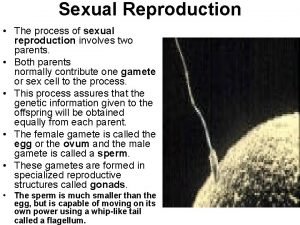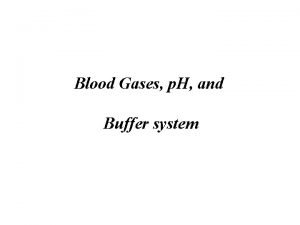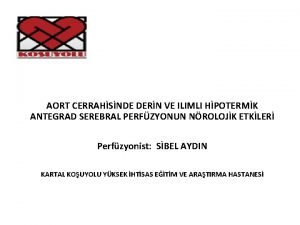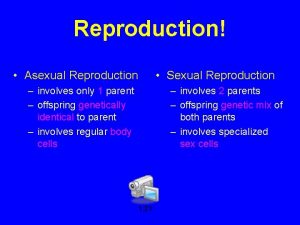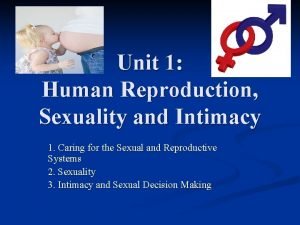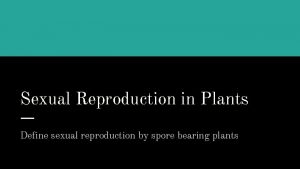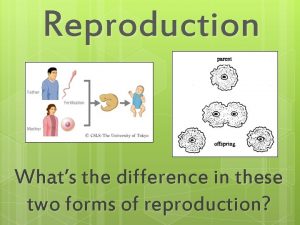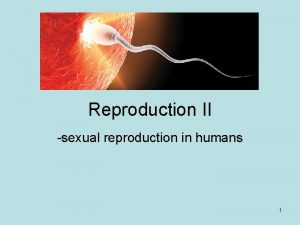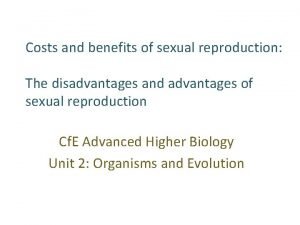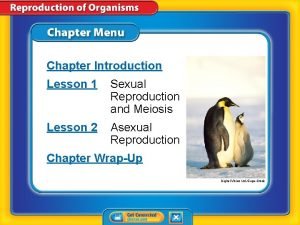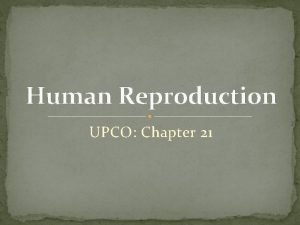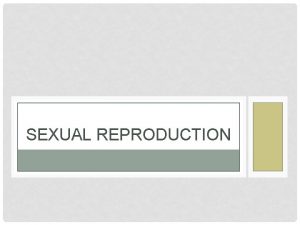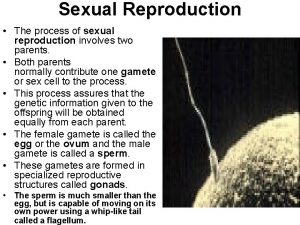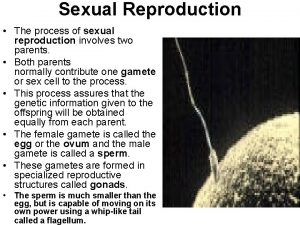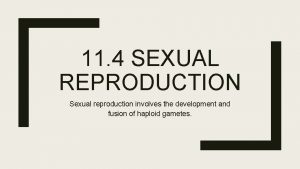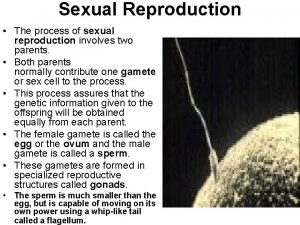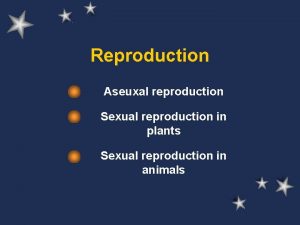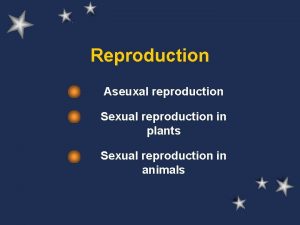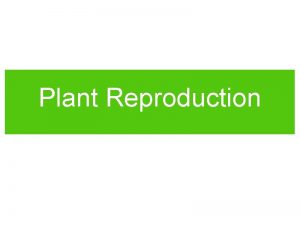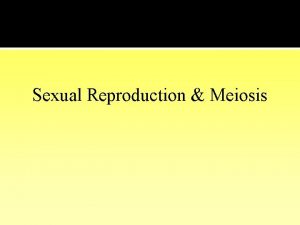Sexual Reproduction UPCO Chapter 20 Sexual Reproduction Involves



















- Slides: 19

Sexual Reproduction UPCO: Chapter 20

Sexual Reproduction Involves 2 parents Offspring are different from the parents Involves the joining of 2 sex cell (gamete- egg and sperm) nuclei Gametes are formed by a type of cell division called MEIOSIS Sex cells fuse during a process called FERTILIZATION The fertilized egg is called a ZYGOTE The zygote divides by MITOSIS and develops into a

Do Now… Answer questions #1 -6 on page 339.

Gametogenesis Is the development of mature sex cells called gametes Involves the process of meiosis of immature sex cells Spermatogenesis- developing sperm in testes Male gamete= sperm, motile Oogenesis- developing eggs in ovaries, 1 lg. egg, 3 polar bodies Female gamete =egg, can’t move, Gametogenesis takes place in gonadsreproductive organs Hermaphrodites have both male and female sex organs

Gametogenesis

Do Now… Answer questions # 1 -4 on page 340.

Fertilization Is the union or joining of an egg and sperm nuclei Sperm (n) unites with egg (n) and forms a diploid (2 n) zygote Fertilization brings back the normal species chromosome number Every organism has its own species chromosome number External fertilization takes place outside the body (fish) Mostly aquatic vertebrates Internal fertilization takes place inside the body (mammals) Mostly in terrestrial vertebrates

Do Now… Answer questions # 1 -10 on pages 341 -342.

Embryonic Development Embryology- the study of the development of an organism from fertilization until birth. Once fertilization takes place the zygote goes thru a number of mitotic divisions called Cleavage results in an embryo. Mitosis causes the zygote to continually divide; 2 cells become 4…. . 4 cells become 8………. A solid ball of cells is formed called a Morula The ball becomes hollow inside- Blastula This stage is followed by the Gastrula stage Ectoderm- outer layer, nervous system, skin, hair, nails Mesoderm- middle layer, muscles, skeleton, circulatory system, reproductive organs Endoderm- inner layer, lining of digestive and respiratory tracts, pars of liver and pancreas

Human Embryonic Development

Do Now… Answer questions #1 -3 on page 343.

External Development After the formation of the 3 primary cell layers the embryo begins to grow and develop Growth- increase in the number and size of cells Development- change in an individual over time External development takes place outside the body of the parent Occurs in both aquatic and terrestrial biomes Eggs with shells evolved to protect the development of an organism on land Most aquatic organisms will die or be eaten before they grow to maturity

Bird Embryo Chorion- membrane under the shell Amnion- under the chorion, encloses amniotic fluid Amniotic Fluid- cushions, nourishes, protects the embryo Yolk Sac- surrounds the yolk, carry food to the embryo Allantois- respiratory membrane and storage area for wastes (uric acid)

Embryonic Membranes of a Bird

Do Now… Answer questions # 1 -8 on pages 344 -345.

Internal Development/ Placental Mammals The embryo grows inside the female parent Greater protection from the environment Mostly mammals develop internally Fewer offspring are usually born Most mammals have a uterus (specialized organ) Developing embryos get nourishment from the placenta thru the umbilical cord Exchange of nutrients, gases, wastes No direct connection between circulatory

Do Now… Answer questions # 1 on page 345, and # 1 -4 on page 346.

Do Now… • Do the Skill Practice on page 351. • Please answer all questions in Part A and Part B.

HW • Complete the Chapter Quiz on pages 353 -354. • There will be an Exam on Friday on Chapter 20 in UPCO. • STUDY, STUDY!!!
 Definition of reproduction
Definition of reproduction Venn diagram of sexual and asexual reproduction
Venn diagram of sexual and asexual reproduction Hare lynx
Hare lynx Sexual vs asexual reproduction venn diagram
Sexual vs asexual reproduction venn diagram üpco
üpco üpco
üpco Chapter 20 sexual reproduction in animals
Chapter 20 sexual reproduction in animals Mendelian genetics
Mendelian genetics Chapter 10 sexual reproduction and genetics
Chapter 10 sexual reproduction and genetics Asexual reproduction involves *
Asexual reproduction involves * Asexual reproduction involves
Asexual reproduction involves A sexual reproduction in humans
A sexual reproduction in humans Define sexual reproduction
Define sexual reproduction Sexual reproduction and genetics section 1 meiosis
Sexual reproduction and genetics section 1 meiosis What is reproduction
What is reproduction Reproduction human
Reproduction human Sexual or asexual reproduction
Sexual or asexual reproduction Connecting the concepts sexual reproduction
Connecting the concepts sexual reproduction Chapter 10 section 3 gene linkage and polyploidy
Chapter 10 section 3 gene linkage and polyploidy Sexual and asexual reproduction
Sexual and asexual reproduction
